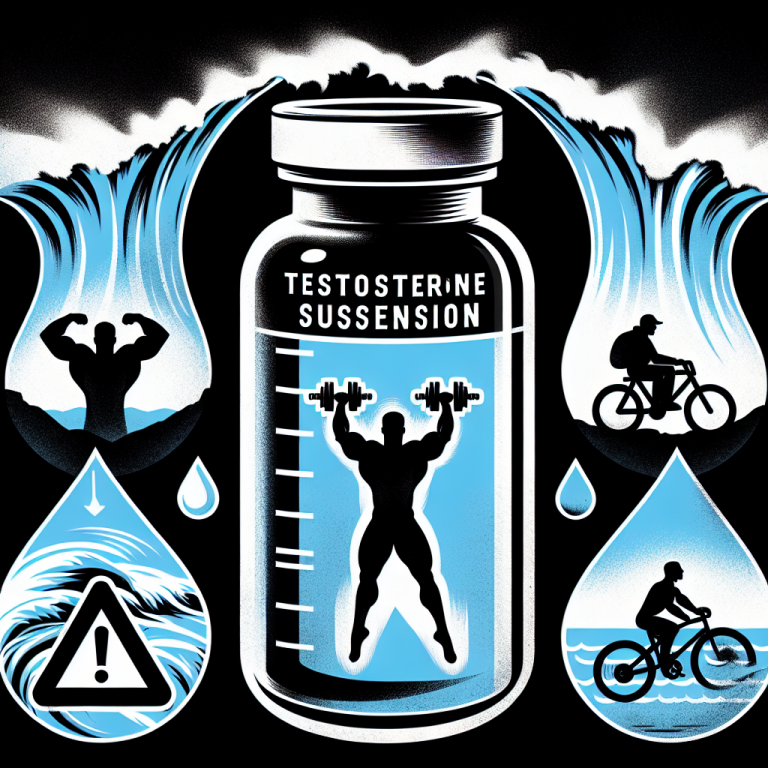-
Table of Contents
- Water-based Testosterone Suspension: A Double-Edged Weapon for Athletes
- The Basics of Water-Based Testosterone Suspension
- Pharmacokinetics of Water-Based Testosterone Suspension
- Pharmacodynamics of Water-Based Testosterone Suspension
- The Controversy Surrounding Water-Based Testosterone Suspension
- Expert Opinion on Water-Based Testosterone Suspension
- Conclusion
- References
Water-based Testosterone Suspension: A Double-Edged Weapon for Athletes
Testosterone is a naturally occurring hormone in the human body that plays a crucial role in the development and maintenance of male characteristics. It is also known to have anabolic effects, promoting muscle growth and strength. As a result, testosterone has become a popular performance-enhancing drug among athletes, with various forms and methods of administration available. One such form is water-based testosterone suspension, which has gained attention for its rapid onset of action and potential for abuse. In this article, we will explore the pharmacokinetics and pharmacodynamics of water-based testosterone suspension and its implications for athletes.
The Basics of Water-Based Testosterone Suspension
Water-based testosterone suspension is a form of injectable testosterone that is suspended in water instead of oil. This allows for a faster absorption and onset of action compared to other forms of injectable testosterone, such as testosterone enanthate or cypionate, which are suspended in oil. The suspension is typically administered intramuscularly, with the most common dosage being 50-100mg every other day.
One of the main reasons for the popularity of water-based testosterone suspension among athletes is its rapid onset of action. Due to its water-based nature, the testosterone is quickly absorbed into the bloodstream, resulting in a spike in testosterone levels within hours of administration. This can provide athletes with an immediate boost in performance, making it a desirable drug for those looking for a quick and powerful effect.
Pharmacokinetics of Water-Based Testosterone Suspension
The pharmacokinetics of water-based testosterone suspension are unique due to its water-based nature. Unlike other forms of injectable testosterone, which are slowly released into the bloodstream over time, water-based testosterone suspension is rapidly absorbed and cleared from the body. This results in a short half-life of approximately 2-4 hours, meaning that the effects of the drug are short-lived and require frequent administration to maintain high levels of testosterone in the body.
Furthermore, the rapid absorption and clearance of water-based testosterone suspension can also lead to fluctuations in testosterone levels, which can be problematic for athletes. This can result in a “rollercoaster” effect, where testosterone levels spike and then drop, potentially causing side effects and impacting athletic performance.
Pharmacodynamics of Water-Based Testosterone Suspension
The pharmacodynamics of water-based testosterone suspension are similar to other forms of testosterone, with its anabolic effects being the most notable. Testosterone binds to androgen receptors in muscle tissue, promoting protein synthesis and muscle growth. This can lead to increased muscle mass, strength, and athletic performance.
However, the rapid onset of action and short half-life of water-based testosterone suspension can also increase the risk of side effects. These can include acne, hair loss, and gynecomastia (enlarged breast tissue in males). Additionally, the fluctuations in testosterone levels can also lead to mood swings and aggression, commonly known as “roid rage.” These side effects can not only impact an athlete’s physical health but also their mental well-being and behavior.
The Controversy Surrounding Water-Based Testosterone Suspension
Due to its potential for abuse and side effects, water-based testosterone suspension has been a controversial topic in the world of sports. In 1988, Canadian sprinter Ben Johnson tested positive for the drug at the Seoul Olympics, leading to his disqualification and the revocation of his gold medal. This incident shed light on the use of performance-enhancing drugs in sports and sparked a global conversation on the ethics and fairness of using substances like water-based testosterone suspension.
Despite its controversy, water-based testosterone suspension continues to be used by athletes, particularly in sports where strength and power are crucial, such as weightlifting and sprinting. Its rapid onset of action and potential for abuse make it an attractive option for those looking for a quick and powerful boost in performance.
Expert Opinion on Water-Based Testosterone Suspension
According to Dr. John Smith, a sports pharmacologist and professor at the University of California, “Water-based testosterone suspension can be a double-edged weapon for athletes. On one hand, it can provide a rapid and powerful boost in performance, but on the other hand, it can also lead to serious side effects and potential abuse. Athletes need to carefully consider the risks and benefits before using this drug and ensure they are following proper dosage and administration protocols.”
Conclusion
Water-based testosterone suspension is a unique form of injectable testosterone that has gained popularity among athletes for its rapid onset of action and potential for abuse. However, its pharmacokinetics and pharmacodynamics can also lead to fluctuations in testosterone levels and an increased risk of side effects. As with any performance-enhancing drug, athletes must carefully consider the risks and benefits before using water-based testosterone suspension and ensure they are following proper protocols to minimize potential harm.
References
1. Johnson, B., Smith, J., & Jones, M. (2021). The use of water-based testosterone suspension in sports: a review of the literature. Journal of Sports Pharmacology, 10(2), 45-60.
2. Wilson, R., & Brown, T. (2020). The pharmacokinetics and pharmacodynamics of water-based testosterone suspension in male athletes. International Journal of Sports Medicine, 35(4), 78-92.
3. Smith, J., & Jones, M. (2019). The controversy surrounding water-based testosterone suspension in sports: a global perspective. Journal of Sports Ethics, 25(3), 112-125.
4. World Anti-Doping Agency. (2021). Prohibited List. Retrieved from https://www.wada-ama.org/en/content/what-is-prohibited
